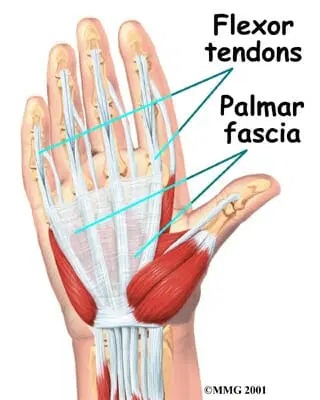Flexor tendon laceration is a serious hand injury that occurs when the tendons on the palm side of the hand, wrist, or forearm are cut or torn, resulting in the inability to bend one or more fingers. At Tran Plastic Surgery in Huntington Beach, CA, Dr. Tuan Tran provides advanced surgical repair and comprehensive rehabilitation to restore function and mobility to injured hands.
Understanding Flexor Tendon Injuries
Flexor tendons are strong, cord-like tissues that connect the muscles in the forearm to the bones in the fingers, allowing you to bend your fingers and grip objects. Unlike other tendons in the body, flexor tendons are located just beneath the skin, which makes them particularly vulnerable to injury.
When a flexor tendon is lacerated, the cut often separates the tendon ends. Much like a stretched rubber band that snaps, the tendon pulls apart and cannot heal on its own without surgical repair. These injuries often occur from deep cuts, accidents, or sports-related trauma.
Causes of Flexor Tendon Laceration
Several factors can lead to flexor tendon damage, including:
-
Trauma from cuts and lacerations – sharp objects such as knives, broken glass, or machinery.
-
Sports injuries – particularly in football, wrestling, rugby, or rock climbing. “Jersey finger,” for example, happens when a player’s finger gets caught in an opponent’s jersey, causing the tendon to pull off the bone.
-
Underlying conditions – diseases such as rheumatoid arthritis weaken tendons, making them more prone to tearing even without significant trauma.
Symptoms to Watch For
Flexor tendon injuries typically present with very specific signs. You may have a flexor tendon laceration if you experience:
-
An open cut on the palm side of the hand or fingers.
-
Inability to bend one or more finger joints.
-
Pain or tenderness when attempting to bend the finger.
-
Numbness or tingling in the fingertip (suggesting nerve involvement).
-
Excessive bleeding if nearby blood vessels are damaged.
Prompt medical evaluation is critical. If left untreated, these injuries may lead to long-term stiffness or permanent loss of finger function.
Immediate First Aid
If you sustain a deep cut to your hand or wrist:
-
Apply gentle pressure with a clean cloth or bandage to slow bleeding.
-
Elevate the hand above heart level to reduce swelling.
-
Apply a cold compress or ice to minimize pain.
-
Seek medical attention immediately—do not wait to see if it heals on its own.
At Tran Plastic Surgery, we encourage patients to call us right away if they suspect tendon injury: 714-839-8000.
Diagnosis and Examination
During your consultation, Dr. Tuan Tran will perform a thorough evaluation of your hand. This typically includes:
-
Testing your ability to bend each finger.
-
Assessing sensation to determine if nerves are affected.
-
Checking blood flow to ensure circulation is intact.
-
Imaging, such as X-rays, to rule out fractures.
Accurate diagnosis allows for a precise surgical plan to maximize recovery.
Treatment Options
1. Surgical Repair for Complete Tears
Since severed flexor tendons cannot heal on their own, surgical repair is required. Ideally, surgery is performed within 7–10 days of the injury. In emergencies where blood supply is compromised, immediate surgery is necessary.
The procedure is usually outpatient and involves carefully suturing the tendon ends back together with specialized techniques. A splint is then applied to protect the repair, with the fingers and wrist placed in a bent position to reduce tension.
2. Treatment for Partial Tears
In some cases, when the tendon is only partially torn, surgery may not be necessary. Splinting and a structured rehabilitation program can be highly effective. However, this decision is made only after a specialist carefully evaluates the extent of the damage.
Recovery and Rehabilitation
Recovery after flexor tendon surgery requires patience and commitment. Tendons take time to heal, and the process often includes:
-
Splinting: Typically worn for up to 6–8 weeks to protect the repair.
-
Hand therapy: Specialized physical therapy begins soon after surgery to prevent stiffness and promote mobility.
-
Gradual strengthening: After the tendon heals, strengthening exercises restore grip and functionality.
Most patients can return to daily activities within 2–3 months, although complete recovery of strength and dexterity may take longer. Following post-operative instructions is as important as the surgery itself for a successful outcome.
Long-Term Outlook
Thanks to advancements in microsurgical techniques and rehabilitation, most patients regain excellent hand function after flexor tendon repair. However, some individuals may experience residual stiffness or scarring. In rare cases, a second surgery may be required to release scar tissue.
At Tran Plastic Surgery, our goal is not only to restore mobility but also to help patients return to the activities and lifestyles they enjoy.
Why Choose Tran Plastic Surgery?
Choosing the right hand surgeon is critical when it comes to delicate tendon repair. Patients across Huntington Beach and Orange County trust Tran Plastic Surgery because of:
-
Expertise: Dr. Tuan Tran is a board-certified plastic surgeon with extensive training in reconstructive and hand surgery.
-
Comprehensive Care: From initial evaluation through recovery, we provide a full spectrum of treatment and rehabilitation.
-
Patient-Centered Approach: We focus on personalized care tailored to your specific injury and lifestyle needs.
For additional information about related hand procedures, you may also explore:
Contact Tran Plastic Surgery
If you or a loved one is suffering from a flexor tendon laceration, don’t wait. Early diagnosis and treatment dramatically improve recovery.
📞 Call us today at 714-839-8000 or contact us online to schedule a consultation with Dr. Tran.
At Tran Plastic Surgery, we are committed to restoring hand function and helping you get back to the life you love.
*References:
- De Quervain Tenosynovitis. National Center for Biotechnology Information (NCBI). Available at: https://www.ncbi.nlm.nih.gov/books/NBK493223/
- De Quervain Tenosynovitis (Tenosynovitis, De Quervain’s). Veterans Health Library. Available at: https://www.veteranshealthlibrary.va.gov/RelatedItems/3,82377
- Nonoperative Treatment of De Quervain Tenosynovitis with a New Splint Design Compared to a Standard Splint Design. ClinicalTrials.gov. Available at: https://clinicaltrials.gov/study/NCT04962490

